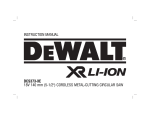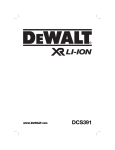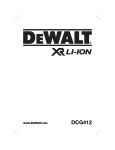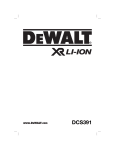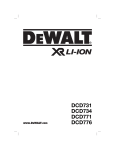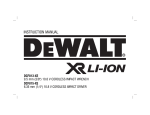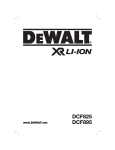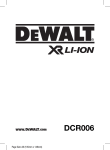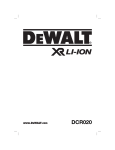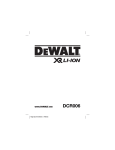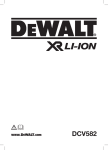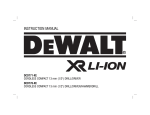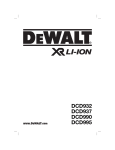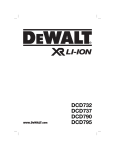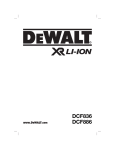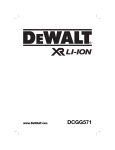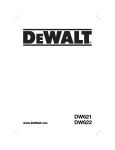Download DeWalt DCS373-XE Technical data
Transcript
DCS373 English (original instructions) 5 Copyright DEWALT B Figure 1 b a u d e l e c n m o k d i h f g j Figure 2 Figure 3 m i i 1 Figure 4 Figure 5 p r f q s t Figure 6 f q r s r q t 2 f Figure 7 Figure 8 A d c B d Figure 9 13 mm (1/2") 3 Figure 10 n o Figure 11 4 ENGLISH 140 mm (5-1/2") 18V CORDLESS METAL-CUTTING CIRCULAR SAW, DCS373 Identify additional safety measures to protect the operator from the effects of vibration such as: maintain the tool and the accessories, keep the hands warm, organisation of work patterns. Congratulations! You have chosen a DEWALT tool. Years of experience, thorough product development and innovation make DEWALT one of the most reliable partners for professional power tool users. Technical Data Voltage Type Max. power output No-load speed Blade diameter Maximum depth of cut Blade bore Weight (without battery pack) VDC W min-1 mm mm mm kg DCS373 18 1/2 460 3700 140 43 20 3.76 Noise values and vibration values (triax vector sum) according to EN60745-2-5: LPA (emission sound pressure level) dB(A) 80 LWA (sound power level) dB(A) 91 KWA (uncertainty for the given sound level) dB(A) 3 Metal cutting Vibration emission value ah,M= Uncertainty K = m/s² m/s² 3.8 1.5 The vibration emission level given in this information sheet has been measured in accordance with a standardised test given in EN 60745 and may be used to compare one tool with another. It may be used for a preliminary assessment of exposure. WARNING: The declared vibration emission level represents the main applications of the tool. However if the tool is used for different applications, with different accessories or poorly maintained, the vibration emission may differ. This may significantly increase the exposure level over the total working period. An estimation of the level of exposure to vibration should also take into account the times when the tool is switched off or when it is running but not actually doing the job. This may significantly reduce the exposure level over the total working period. Battery pack Battery type Voltage Capacity Weight Battery pack Battery type Voltage Capacity Weight Charger Mains voltage Battery type Approximate charging time of battery packs Weight Charger Mains voltage Battery type Approximate charging time of battery packs Weight Charger Mains voltage Battery type Approximate charging time of battery packs Weight VDC Ah kg DCB180 Li-Ion 18 3.0 0.64 DCB181 Li-Ion 18 1.5 0.35 DCB182 Li-Ion 18 4.0 0.61 VDC Ah kg DCB183 Li-Ion 18 2.0 0.40 DCB184 Li-Ion 18 5.0 0.62 DCB185 Li-Ion 18 1.3 0.35 VAC min 25 (1.3 Ah) 55 (3.0 Ah) kg VAC min 60 (1.3 Ah) 140 (3.0 Ah) kg VAC min kg 40 (1.3 Ah) 90 (3.0 Ah) DCB105 230 V Li-Ion 30 (1.5 Ah) 70 (4.0 Ah) 0.49 DCB107 230 V Li-Ion 70 (1.5 Ah) 185 (4.0 Ah) 0.29 DCB112 230 V Li-Ion 45 (1.5 Ah) 120 (4.0 Ah) 0.36 40 (2.0 Ah) 90 (5.0 Ah) 90 (2.0 Ah) 240 (5.0 Ah) 60 (2.0 Ah) 150 (5.0 Ah) 5 ENGLISH Fuses: Europe U.K. & Ireland 230 V tools 230 V tools 10 Amperes, mains 3 Amperes, in plugs Definitions: Safety Guidelines The definitions below describe the level of severity for each signal word. Please read the manual and pay attention to these symbols. DANGER: Indicates an imminently hazardous situation which, if not avoided, will result in death or serious injury. WARNING: Indicates a potentially hazardous situation which, if not avoided, could result in death or serious injury. CAUTION: Indicates a potentially hazardous situation which, if not avoided, may result in minor or moderate injury. NOTICE: Indicates a practice not related to personal injury which, if not avoided, may result in property damage. Denotes risk of electric shock. Denotes risk of fire. EC-Declaration of Conformity MACHINERY DIRECTIVE CORDLESS METAL-CUTTING CIRCULAR SAW DCS373 DEWALT declares that these products described under Technical data are in compliance with: 2006/42/EC, EN 60745-1, EN 60745-2-5. These products also comply with Directive 2004/108/EC (until 19.04.2016), 2014/30/EU (from 20.04.2016) and 2011/65/EU. For more information, please contact DEWALT at the following address or refer to the back of the manual. The undersigned is responsible for compilation of the technical file and makes this declaration on behalf of DEWALT. 6 Horst Grossmann Vice President Engineering DEWALT, Richard-Klinger-Straße 11, D-65510, Idstein, Germany 15.11.2014 WARNING: To reduce the risk of injury, read the instruction manual. General Power Tool Safety Warnings WARNING! Read all safety warnings and all instructions. Failure to follow the warnings and instructions may result in electric shock, fire and/or serious injury. SAVE ALL WARNINGS AND INSTRUCTIONS FOR FUTURE REFERENCE The term “power tool” in the warnings refers to your mains-operated (corded) power tool or batteryoperated (cordless) power tool. 1) WORK AREA SAFETY a) Keep work area clean and well lit. Cluttered or dark areas invite accidents. b) Do not operate power tools in explosive atmospheres, such as in the presence of flammable liquids, gases or dust. Power tools create sparks which may ignite the dust or fumes. c) Keep children and bystanders away while operating a power tool. Distractions can cause you to lose control. 2) ELECTRICAL SAFETY a) Power tool plugs must match the outlet. Never modify the plug in any way. Do not use any adapter plugs with earthed (grounded) power tools. Unmodified plugs and matching outlets will reduce risk of electric shock. b) Avoid body contact with earthed or grounded surfaces such as pipes, radiators, ranges and refrigerators. There is an increased risk of electric shock if your body is earthed or grounded. c) Do not expose power tools to rain or wet conditions. Water entering a power tool will increase the risk of electric shock. d) Do not abuse the cord. Never use the cord for carrying, pulling or unplugging the power tool. Keep cord away from heat, oil, sharp edges o r moving parts. Damaged or entangled cords increase the risk of electric shock. e) When operating a power tool outdoors, use an extension cord suitable for outdoor ENGLISH f) use. Use of a cord suitable for outdoor use reduces the risk of electric shock. If operating a power tool in a damp location is unavoidable, use a residual current device (RCD) protected supply. Use of an RCD reduces the risk of electric shock. 3) PERSONAL SAFETY a) Stay alert, watch what you are doing and use common sense when operating a power tool. Do not use a power tool while you are tired or under the influence of drugs, alcohol or medication. A moment of inattention while operating power tools may result in serious personal injury. b) Use personal protective equipment. Always wear eye protection. Protective equipment such as dust mask, non-skid safety shoes, hard hat, or hearing protection used for appropriate conditions will reduce personal injuries. c) Prevent unintentional starting. Ensure the switch is in the off position before connecting to power source and/or battery pack, picking up or carrying the tool. Carrying power tools with your finger on the switch or energising power tools that have the switch on invites accidents. d) Remove any adjusting key or wrench before turning the power tool on. A wrench or a key left attached to a rotating part of the power tool may result in personal injury. e) Do not overreach. Keep proper footing and balance at all times. This enables better control of the power tool in unexpected situations. f) Dress properly. Do not wear loose clothing or jewellery. Keep your hair, clothing and gloves away from moving parts. Loose clothes, jewellery or long hair can be caught in moving parts. g) If devices are provided for the connection of dust extraction and collection facilities, ensure these are connected and properly used. Use of dust collection can reduce dust-related hazards. 4) POWER TOOL USE AND CARE a) Do not force the power tool. Use the correct power tool for your application. The correct power tool will do the job better and safer at the rate for which it was designed. b) Do not use the power tool if the switch does not turn it on and off. Any power c) d) e) f) g) tool that cannot be controlled with the switch is dangerous and must be repaired. Disconnect the plug from the power source and/or the battery pack from the power tool before making any adjustments, changing accessories, or storing power tools. Such preventive safety measures reduce the risk of starting the power tool accidentally. Store idle power tools out of the reach of children and do not allow persons unfamiliar with the power tool or these instructions to operate the power tool. Power tools are dangerous in the hands of untrained users. Maintain power tools. Check for misalignment or binding of moving parts, breakage of parts and any other condition that may affect the power tool’s operation. If damaged, have the power tool repaired before use. Many accidents are caused by poorly maintained power tools. Keep cutting tools sharp and clean. Properly maintained cutting tools with sharp cutting edges are less likely to bind and are easier to control. Use the power tool, accessories and tool bits etc., in accordance with these instructions taking into account the working conditions and the work to be performed. Use of the power tool for operations different from those intended could result in a hazardous situation. 5) BATTERY TOOL USE AND CARE a) Recharge only with the charger specified by the manufacturer. A charger that is suitable for one type of battery pack may create a risk of fire when used with another battery pack. b) Use power tools only with specifically designated battery packs. Use of any other battery packs may create a risk of injury and fire. c) When battery pack is not in use, keep it away from other metal objects like paper clips, coins, keys, nails, screws or other small metal objects that can make a connection from one terminal to another. Shorting the battery terminals together may cause burns or a fire. d) Under abusive conditions, liquid may be ejected from the battery, avoid contact. If contact accidentally occurs, flush with water. If liquid contacts eyes, additionally seek medical help. Liquid ejected from the battery may cause irritation or burns. 7 ENGLISH 6) SERVICE a) Have your power tool serviced by a qualified repair person using only identical replacement parts. This will ensure that the safety of the power tool is maintained. Safety Instructions for All Saws a) DANGER: Keep hands away from cutting area and the blade. Keep your second hand on auxiliary handle, or motor housing. If both hands are holding the saw, they cannot be cut by the blade. b) Do not reach underneath the workpiece. The guard cannot protect you from the blade below the workpiece. c) Adjust the cutting depth to the thickness of the workpiece. Less than a full tooth of the blade teeth should be visible below the workpiece. d) Never hold piece being cut in your hands or across your leg. Secure the workpiece to a stable platform. It is important to support the work properly to minimise body exposure, blade binding, or loss of control. e) Hold power tool by insulated gripping surfaces when performing an operation where the cutting tool may contact hidden wiring. Contact with a “live” wire will also make exposed metal parts of the power tool “live” and shock the operator. f) When ripping always use a rip fence or straight edge guide. This improves the accuracy of cut and reduces the chance of blade binding. g) Always use blades with correct size and shape (diamond versus round) of arbour holes. Blades that do not match the mounting hardware of the saw will run eccentrically, causing loss of control. h) Never use damaged or incorrect blade washers or bolt. The blade washers and bolt were specially designed for your saw, for optimum performance and safety of operation. Further Safety Instructions for All Saws CAUSES AND OPERATOR PREVENTION OF KICKBACK – Kickback is a sudden reaction to a pinched, bound or misaligned saw blade, causing an uncontrolled saw to lift up and out of the workpiece toward the operator; 8 – When the blade is pinched or bound tightly by the kerf closing down, the blade stalls and the motor reaction drives the unit rapidly back toward the operator; – If the blade becomes twisted or misaligned in the cut, the teeth at the back edge of the blade can dig into the top surface of the wood causing the blade to climb out of the kerf and jump back toward the operator. Kickback is the result of saw misuse and/or incorrect operating procedures or conditions and can be avoided by taking proper precautions as given below: a) Maintain a firm grip with both hands on the saw and position your arms to resist kickback forces. Position your body to either side of the blade, but not in line with the blade. Kickback could cause the saw to jump backwards, but kickback forces can be controlled by the operator, if proper precautions are taken. b) When blade is binding, or when interrupting a cut for any reason, release the trigger and hold the saw motionless in the material until the blade comes to a complete stop. Never attempt to remove the saw from the work or pull the saw backward while the blade is in motion or kickback may occur. Investigate and take corrective actions to eliminate the cause of blade binding. c) When restarting a saw in the workpiece, centre the saw blade in the kerf and check that saw teeth are not engaged into the material. If saw blade is binding, it may walk up or kickback from the workpiece as the saw is restarted. d) Support large panels to minimise the risk of blade pinching and kickback. Large panels tend to sag under their own weight. Supports must be placed under the panel on both sides, near the line of cut and near the edge of the panel. e) Do not use dull or damaged blades. Unsharpened or improperly set blades produce narrow kerf causing excessive friction, blade binding and kickback. f) Blade depth and bevel adjusting locking levers must be tight and secure before making cut. If blade adjustment shifts while cutting, it may cause binding and kickback. g) Use extra caution when sawing into existing walls or other blind areas. The protruding blade may cut objects that can cause kickback. ENGLISH Lower Guard Safety Instructions a) Check lower guard for proper closing before each use. Do not operate the saw if lower guard does not move freely and close instantly. Never clamp or tie the lower guard into the open position. If saw is accidentally dropped, lower guard may be bent. Raise the lower guard with the retracting handle and make sure it moves freely and does not touch the blade or any other part, in all angles and depths of cut. b) Check the operation of the lower guard spring. If the guard and the spring are not operating properly, they must be serviced before use. Lower guard may operate sluggishly due to damaged parts, gummy deposits, or a build-up of debris. c) Lower guard should be retracted manually only for special cuts such as “plunge cuts” and “compound cuts.” Raise lower guard by retracting handle and as soon as blade enters the material, the lower guard must be released. For all other sawing, the lower guard should operate automatically. d) Always observe that the lower guard is covering the blade before placing saw down on bench or floor. An unprotected, coasting blade will cause the saw to walk backwards, cutting whatever is in its path. Be aware of the time it takes for the blade to stop after switch is released. NOTE: Although the above information references wood, this saw is only to be used to cut metal. Kickback can occur when cutting metal. Additional Specific Safety Instructions for Circular Saws • Do not use abrasive wheels or blades. • Do not use water feed attachments. • Do not attempt to cut stainless steel, rebar, hardened or heat-treated steel, cast iron, masonry or unknown materials • Use clamps or another practical way to secure and support the workpiece to a stable platform. Holding the work by hand or against your body leaves it unstable and may lead to loss of control. • Keep your body positioned to either side of the blade, but not in line with the saw blade. KICKBACK could cause the saw to jump backwards (see Causes and Operator Prevention of Kickback and KICKBACK). • Air vents often cover moving parts and should be avoided. Loose clothes, jewellery or long hair can be caught in moving parts. • Wear ear protectors. Exposure to noise can cause hearing loss. • Wear a dust mask. Exposure to dust particles can cause breathing difficulty and possible injury. • Do not use blades of larger or smaller diameter than recommended. For the proper blade rating refer to the Technical Data. Use only the blades specified in this manual, complying with EN 847-1. • When not in use, place circular saw on a stable surface, shoe side down, where it will not cause a tripping or falling hazard. Some tools with large battery packs will stand upright on the battery pack but may be easily knocked over. Residual Risks The following risks are inherent to the use of circular saws. – Injuries caused by touching the rotating parts or hot part of the tool. In spite of the application of the relevant safety regulations and the implementation of safety devices, certain residual risks cannot be avoided. These are: – Impairment of hearing. – Risk of squeezing fingers when changing the accessory. – Health hazards caused by breathing dust developed when working in wood. Markings on Tool The following pictograms are shown on the tool: Read instruction manual before use. Wear ear protection. Wear eye protection. Metal cutting only. DATE CODE POSITION (FIG. 1) The date code (u), which also includes the year of manufacture, is printed into the housing surface that forms the mounting joint between tool and battery. 9 ENGLISH Example: 2015 XX XX Year of Manufacture Important Safety Instructions for All Battery Chargers SAVE THESE INSTRUCTIONS: This manual contains important safety and operating instructions for the DCB105, DCB107 and DCB112 battery chargers. • Before using the charger, read all instructions and cautionary markings on charger, battery pack and product using the battery pack. WARNING: Shock hazard. Do not allow any liquid to get inside charger. Electric shock may result. WARNING: We recommend the use of a residual current device with a residual current rating of 30mA or less. CAUTION: Burn hazard. To reduce the risk of injury, charge only DEWALT rechargeable battery packs. Other types of batteries may overheat and burst resulting in personal injury and property damage. CAUTION: Children should be supervised to ensure that they do not play with the appliance. NOTICE: Under certain conditions, with the charger plugged in to the power supply, the exposed charging contacts inside the charger can be shorted by foreign material. Foreign materials of a conductive nature such as, but not limited to, steel wool, aluminum foil or any buildup of metallic particles should be kept away from charger cavities. Always unplug the charger from the power supply when there is no battery pack in the cavity. Unplug charger before attempting to clean. • DO NOT attempt to charge the battery pack with any chargers other than the ones in this manual. The charger and battery pack are specifically designed to work together. • These chargers are not intended for any uses other than charging DEWALT rechargeable batteries. Any other uses may result in risk of fire, electric shock or electrocution. • Do not expose charger to rain or snow. 10 • Pull by plug rather than cord when disconnecting charger. This will reduce risk of damage to electric plug and cord. • Make sure that cord is located so that it will not be stepped on, tripped over or otherwise subjected to damage or stress. • Do not use an extension cord unless it is absolutely necessary. Use of improper extension cord could result in risk of fire, electric shock or electrocution. • When operating a charger outdoors, always provide a dry location and use an extension cord suitable for outdoor use. Use of a cord suitable for outdoor use reduces the risk of electric shock. • Do not block the ventilation slots on the charger. The ventilation slots are located on the top and sides of the charger. Place the charger in a position away from any heat source. • Do not operate charger with damaged cord or plug — have them replaced immediately. • Do not operate charger if it has received a sharp blow, been dropped or otherwise damaged in any way. Take it to an authorised service centre. • Do not disassemble the charger; take it to an authorised service centre when service or repair is required. Incorrect reassembly may result in a risk of electric shock, electrocution or fire. • In case of damaged power supply cord the supply cord must be replaced immediately by the manufacturer, its service agent or similar qualified person to prevent any hazard. • Disconnect the charger from the outlet before attempting any cleaning. This will reduce the risk of electric shock. Removing the battery pack will not reduce this risk. • NEVER attempt to connect 2 chargers together. • The charger is designed to operate on standard 230 V household electrical power. Do not attempt to use it on any other voltage. This does not apply to the vehicular charger. SAVE THESE INSTRUCTIONS Chargers The DCB105, DCB107 and DCB112 chargers accept 10.8 V, 14.4 V and 18 V XR Li-Ion (DCB123, DCB125, DCB127, DCB140, DCB141, DCB142, ENGLISH DCB143, DCB144, DCB145, DCB180, DCB181, DCB182, DCB183, DCB184 and DCB185) battery packs. If the charger indicates a problem, take the charger and battery pack to be tested at an authorised service centre. These chargers require no adjustment and are designed to be as easy as possible to operate. HOT/COLD PACK DELAY Charging Procedure (fig. 2) 1. Plug the charger into an appropriate outlet before inserting battery pack. 2. Insert the battery pack (i) into the charger, making sure the pack is fully seated in the charger. The red (charging) light will blink continuously indicating that the charging process has started. 3. The completion of charge will be indicated by the red light remaining ON continuously. The pack is fully charged and may be used at this time or left in the charger. NOTE: To ensure maximum performance and life of Li-Ion batteries, charge the battery pack fully before first use. Charging Process Refer to the table below for the charge status of the battery pack. Charge indicators: DCB105 x charging –– –– –– –– –– –– –– fully charged –––––––––––––––––––– hot/cold pack delay ––– • ––– • ––– • ––– replace battery pack •••••••••••••• Charge indicators: DCB107, DCB112 charging –– –– –– –– –– fully charged –––––––––––––– hot/cold pack delay* –– –– –– ––––– * DCB107, DCB112: The red light will continue to blink, but a yellow indicator light will be illuminated during this operation. Once the battery has reached an appropriate temperature, the yellow light will turn off and the charger will resume the charging procedure. The compatible charger(s) will not charge a faulty battery pack. The charger will indicate faulty battery by refusing to light or by displaying problem pack or charger blink pattern. NOTE: This could also mean a problem with a charger. When the charger detects a battery that is too hot or too cold, it automatically starts a Hot/Cold Pack Delay, suspending charging until the battery has reached an appropriate temperature. The charger then automatically switches to the pack charging mode. This feature ensures maximum battery life. A cold battery pack will charge at about half the rate of a warm battery pack. The battery pack will charge at that slower rate throughout the entire charging cycle and will not return to maximum charge rate even if the battery warms. LITHIUM ION BATTERY PACKS ONLY XR Li-Ion tools are designed with an Electronic Protection System that will protect the battery against overloading, overheating or deep discharge. The tool will automatically turn off if the Electronic Protection System engages. If this occurs, place the Li-Ion battery on the charger until it is fully charged. Important Safety Instructions for All Battery Packs When ordering replacement battery packs, be sure to include the catalog number and voltage. The battery pack is not fully charged out of the carton. Before using the battery pack and charger, read the safety instructions below and then follow the charging procedures outlined. READ ALL INSTRUCTIONS • Do not charge or use the battery pack in explosive atmospheres, such as in the presence of flammable liquids, gases or dust. Inserting or removing the battery pack from the charger may ignite the dust or fumes. • Never force the battery pack into charger. Do not modify the battery pack in any way to fit into a non-compatible charger as battery pack may rupture causing serious personal injury. • Charge the battery packs only in designated DEWALT chargers. • DO NOT splash or immerse in water or other liquids. • Do not store or use the tool and battery pack in locations where the temperature may reach or exceed 40 °C (105 °F) (such as outside sheds or metal buildings in summer). 11 ENGLISH • For best results, make sure the battery pack is fully charged before use. WARNING: Never attempt to open the battery pack for any reason. If the battery pack case is cracked or damaged, do not insert it into the charger. Do not crush, drop or damage battery pack. Do not use a battery pack or charger that has received a sharp blow, been dropped, run over or damaged in any way (e.g., pierced with a nail, hit with a hammer, stepped on). Electric shock or electrocution may result. Damaged battery packs should be returned to the service centre for recycling. CAUTION: When not in use, place tool on its side on a stable surface where it will not cause a tripping or falling hazard. Some tools with large battery packs will stand upright on the battery pack but may be easily knocked over. SPECIFIC SAFETY INSTRUCTIONS FOR LITHIUM ION (Li-Ion) • Do not incinerate the battery pack even if it is severely damaged or is completely worn out. The battery pack can explode in a fire. Toxic fumes and materials are created when lithium ion battery packs are burned. • If battery contents come into contact with the skin, immediately wash the area with mild soap and water. If the battery liquid gets into the eye, rinse water over the open eye for 15 minutes or until irritation ceases. If medical attention is needed, the battery electrolyte is composed of a mixture of liquid organic carbonates and lithium salts. • Contents of opened battery cells may cause respiratory irritation. Provide fresh air. If symptoms persists, seek medical attention. WARNING: Burn hazard. Battery liquid may be flammable if exposed to spark or flame. Transportation DEWALT batteries comply with all applicable shipping regulations as prescribed by industry and legal standards which include UN Recommendations on the Transport of Dangerous Goods; International Air Transport Association (IATA) Dangerous Goods Regulations, International Maritime Dangerous Goods (IMDG) Regulations, and the European 12 Agreement Concerning The International Carriage of Dangerous Goods by Road (ADR). Lithium-ion cells and batteries have been tested to section 38.3 of the UN Recommendations on the Transport of Dangerous Goods Manual of Tests and Criteria. In most instances, shipping a DEWALT battery pack will be excepted from being classified as a fully regulated Class 9 Hazardous material. In general, the two instances that require shipping Class 9 are: 1. Air shipping more than two DEWALT lithium-ion battery packs when the package contains only battery packs (no tools), and 2. Any shipment containing a lithium-ion battery with an energy rating greater than 100 watt hours (Wh). All lithium-ion batteries have the watt hour rating marked on the pack. Regardless of whether a shipment is considered excepted or fully regulated, it is the shipper's responsibility to consult the latest regulations for packaging, labeling/marking and documentation requirements. Transporting batteries can possibly cause fire if the battery terminals inadvertently come in contact with conductive materials. When transporting batteries, make sure that the battery terminals are protected and well insulated from materials that could contact them and cause a short circuit. The information provided in this section of the manual is provided in good faith and believed to be accurate at the time the document was created. However, no warranty, expressed or implied, is given. It is the buyer’s responsibility to ensure that its activities comply with the applicable regulations. Battery Pack BATTERY TYPE The DCS373 operates on an 18V XR Li-Ion battery pack. The DCB180, DCB181, DCB182, DCB183, DCB184 and DCB185 battery packs may be used. Refer to Technical Data for more information. Storage Recommendations 1. The best storage place is one that is cool and dry away from direct sunlight and excess heat or cold. For optimum battery performance and life, store battery packs at room temperature when not in use. 2. For long storage, it is recommended to store a fully charged battery pack in a cool, dry place out of the charger for optimal results. ENGLISH NOTE: Battery packs should not be stored completely depleted of charge. The battery pack will need to be recharged before use. Package Contents The package contains: 1 Cordless metal-cutting circular saw Labels on Charger and Battery Pack 1 30 tooth blade In addition to the pictographs used in this manual, the labels on the charger and the battery pack show the following pictographs: 2 Li-Ion battery packs (M2 models) 1 Hex key 1 Kitbox 1 Charger Read instruction manual before use. 1 Instruction manual NOTE: Battery packs, chargers and kitboxes are not included with N-models. See Technical Data for charging time. Battery charging. Battery charged. Battery defective. • Check for damage to the tool, parts or accessories which may have occurred during transport. • Take the time to thoroughly read and understand this manual prior to operation. Description (fig. 1, 4–6) WARNING: Never modify the power tool or any part of it. Damage or personal injury could result. Hot/cold pack delay. Do not probe with conductive objects. a. Trigger switch b. Trigger switch lock-off button Do not charge damaged battery packs. c. Depth adjustment lever d. Spindle lock button Do not expose to water. e. Kerf indicator Have defective cords replaced immediately. g. Lower guard f. Blade clamping screw Charge only between 4 ˚C and 40 ˚C. h. Lower guard retracting lever i. Battery pack j. Sight window Only for indoor use. k. Shoe l. Hex key Discard the battery pack with due care for the environment. Charge DEWALT battery packs only with designated DEWALT chargers. Charging battery packs other than the designated DEWALT batteries with a DEWALT charger may make them burst or lead to other dangerous situations. m. Battery release button n. Main handle o. Auxiliary handle p. Fuel gauge button (fig. 4) q. Inner clamp washer (fig. 5, 6) r. Outer clamp washer (fig. 5, 6) s. Saw spindle (fig. 5, 6) t. Blade (fig. 5, 6) Do not incinerate the battery pack. INTENDED USE This metal-cutting circular saw is intended for use by professionals for cutting light gauge metals and small metal structural shapes. 13 ENGLISH DO NOT use under wet conditions or in presence of flammable liquids or gases. This metal-cutting circular saw is a professional power tool. DO NOT let children come into contact with the tool. Supervision is required when inexperienced operators use this tool. • This product is not intended for use by persons (including children) suffering from diminished physical, sensory or mental abilities; lack of experience, knowledge or skills unless they are supervised by a person responsible for their safety. Children should never be left alone with this product. WARNING: Do not plunge cut or pocket cut with this saw. WINDOW (FIG. 1) WARNING: Do not operate the saw with a damaged or missing sight window. If window is damaged or missing, have the saw serviced at an authorised service centre. If saw is operated without the window, metal chips could fly through the guard and cause personal injury. CAUTION: Do not use oil or cutting fluids with the metal-cutting saw. Do not use cleaning fluids to clean window. Cleaning fluids, cutting fluids or oils could harm the plastic in the window, interfering with the safe operation of the saw. The saw is equipped with a sight window (j) on the side of the upper guard. This window allows the user to see a cutting line on the material to be cut. SAW SHOE (FIG. 1) The front of the saw shoe (k) has a kerf indicator (e) that allows the operator to glide the saw along cutting lines. Aligning the cutting line with the notch on the front of the shoe and centering it using the modified V-shaped kerf indicator allows the operator to keep the blade in line with the cutting line. If the cutting line is visible through the narrowest part of the kerf indicator, the blade will pass directly over the cutting line. WORKLIGHT The saw is equipped with a worklight that is activated when the trigger switch is depressed. The light will automatically turn off 20 seconds after the trigger switch is released. If the trigger switch remains depressed, the worklight will remain on. 14 NOTE: The worklight is for lighting the immediate work surface and is not intended to be used as a flashlight. Electrical Safety The electric motor has been designed for one voltage only. Always check that the battery pack voltage corresponds to the voltage on the rating plate. Also make sure that the voltage of your charger corresponds to that of your mains. Your DEWALT charger is double insulated in accordance with EN 60335; therefore no earth wire is required. If the supply cord is damaged, it must be replaced by a specially prepared cord available through the DEWALT service organization. Mains Plug Replacement (U.K. & Ireland Only) If a new mains plug needs to be fitted: • Safely dispose of the old plug. • Connect the brown lead to the live terminal in the plug. • Connect the blue lead to the neutral terminal. WARNING: No connection is to be made to the earth terminal. Follow the fitting instructions supplied with good quality plugs. Recommended fuse: 3 A. Using an Extension Cable An extension cord should not be used unless absolutely necessary. Use an approved extension cable suitable for the power input of your charger (see Technical Data). The minimum conductor size is 1 mm2; the maximum length is 30 m. When using a cable reel, always unwind the cable completely ASSEMBLY AND ADJUSTMENTS WARNING: To reduce the risk of serious personal injury, turn tool off and disconnect battery pack before making any adjustments or removing/installing attachments or accessories. An accidental start-up can cause injury. WARNING: Use only DEWALT battery packs and chargers. ENGLISH Inserting and Removing the Battery Pack from the Tool (fig. 3) NOTE: For best results, make sure your battery pack is fully charged. The light will shut off without warning when the battery is fully discharged. TO INSTALL THE BATTERY PACK INTO THE TOOL HANDLE 1. Align the battery pack (i) with the rails inside the tool’s handle (fig. 3). 2. Slide it into the handle until the battery pack is firmly seated in the tool and ensure that it does not disengage. TO REMOVE THE BATTERY PACK FROM THE TOOL 1. Press the battery release button (m) and firmly pull the battery pack out of the tool handle. 2. Insert battery pack into the charger as described in the charger section of this manual. FUEL GAUGE BATTERY PACKS (FIG. 4) Some DEWALT battery packs include a fuel gauge which consists of three green LED lights that indicate the level of charge remaining in the battery pack. To actuate the fuel gauge, press and hold the fuel gauge button (p). A combination of the three green LED lights will illuminate designating the level of charge left. When the level of charge in the battery is below the usable limit, the fuel gauge will not illuminate and the battery will need to be recharged. NOTE: The fuel gauge is only an indication of the charge left on the battery pack. It does not indicate tool functionality and is subject to variation based on product components, temperature and end-user application. Trigger Switch (fig. 1) WARNING: This tool has no provision to lock the trigger switch in the ON position and should never be locked ON by any other means. The saw is controlled by a trigger switch (a) and lock-off button (b). The lock-off button must be pressed before the trigger switch will turn the saw on. Releasing the trigger turns the saw off. Changing Blades (fig. 1, 5–7) TO INSTALL THE BLADE 1. Place inner clamp washer (q) on saw spindle (s) with the large flat surface facing out toward the blade (fig. 5, 6). 2. Retract the lower blade guard (g) and place blade (t) on saw spindle against the inner clamp washer (q), making sure that the blade will rotate in the proper direction (the direction of the rotation arrow on the saw blade and the teeth must point in the same direction as the direction of rotation arrow on the saw). Do not assume that the printing on the blade will always be facing you when properly installed. When retracting the lower blade guard to install the blade, check the condition and operation of the lower blade guard to assure that it is working properly. Make sure it moves freely and does not touch the blade or any other part, in all angles and depths of cut. 3. Place the outer clamp washer (r) on the saw spindle (s) with the large flat surface against the blade (t) with beveled side facing out. 4. Thread the blade clamping screw (f) into the saw spindle by hand. (Screw has left-hand threads and must be turned counterclockwise to tighten. Refer to arrow in Figure 7A.) 5. Depress the spindle lock button (d) while turning the saw spindle with the hex key (l, fig. 1) until the spindle lock engages and the blade stops rotating. 6. Tighten the blade clamping screw firmly with the hex key. NOTICE: Never engage the spindle lock while saw is running, or engage in an effort to stop the tool. Never turn the saw on while the spindle lock is engaged. Serious damage to your saw will result. TO REPLACE THE BLADE 1. To loosen the blade clamping screw (f), depress the spindle lock button (d) and turn the saw spindle (s) with the hex key (l) until the spindle lock engages and the blade stops rotating. With the spindle lock engaged, turn the blade clamping screw clockwise with the hex key. (Screw has left-hand threads and must be turned clockwise to loosen. Refer to arrow in Figure 7B.) 2. Remove the blade clamping screw (f) and outer clamp washer (r) only. Remove old blade. 3. Clean any metal chips/shavings that may have accumulated in the guard or clamp washer area and check the condition and operation of the lower blade guard as previously outlined. Do not lubricate this area. 15 ENGLISH 4. Select the proper blade for the application (see Blades). Always use blades that are the correct size (diameter) with the proper size and shape centre hole for mounting on the saw spindle. Always assure that the maximum recommended speed (rpm) on the saw blade meets or exceeds the speed (rpm) of the saw. 5. Follow steps 2 through 6 under To Install the Blade, making sure that the blade will rotate in the proper direction. LOWER BLADE GUARD WARNING: Under certain conditions of use, metal chips may become imbedded in the surfaces of the lower guard, causing the lower guard to rub against the upper guard. Check the operation of the lower guard before each use and remove any imbedded chips. WARNING: The lower blade guard is a safety feature which reduces the risk of serious personal injury. Never use the saw if the lower guard is missing, damaged, misassembled or not working properly. Do not rely on the lower blade guard to protect you under all circumstances. Your safety depends on following all warnings and precautions as well as proper operation of the saw. Check lower guard for proper closing before each use as outlined in Additional Safety Rules for Circular Saws. If the lower blade guard is missing or not working properly, have the saw serviced before using. To assure product safety and reliability, repair, maintenance and adjustment should be performed by an authorised service centre or other qualified service organization, always using identical replacement parts. BLADES WARNING: To minimise the risk of eye injury, always use eye protection. Carbide is a hard but brittle material. Foreign objects in the workpiece such as wire or nails can cause tips to crack or break. Only operate saw when proper saw blade guard is in place. Mount blade securely in proper rotation before using, and always use a clean, sharp blade. 16 Blade Diameter DT1212-QZ 140 mm (5-1/2") Teeth Application 30 General purpose ferrous metal cutting If you need assistance regarding blades, please contact your local DEWALT dealer. KICKBACK Kickback is a sudden reaction to a pinched, bound or misaligned saw blade, causing an uncontrolled saw to lift up and out of the workpiece toward the operator. When the blade is pinched or bound tightly by the kerf closing down, the blade stalls and the motor reaction drives the unit rapidly back toward the operator. If the blade becomes twisted or misaligned in the cut, the teeth at the back edge of the blade can dig into the top surface of the material causing the blade to climb out of the kerf and jump back toward the operator. Kickback is more likely to occur when any of the following conditions exists. 1. IMPROPER WORKPIECE SUPPORT A. Sagging or improper lifting of the cut off piece can cause pinching of the blade and lead to kickback (fig. 9). B. Cutting through material supported at the outer ends only can cause kickback. As the material weakens it sags, closing down the kerf and pinching the blade (fig. 9). C. Cutting off a cantilevered or overhanging piece of material from the bottom up in a vertical direction can cause kickback. The falling cut off piece can pinch the blade. D. Cutting off long narrow strips can cause kickback. The cut off strip can sag or twist closing the kerf and pinching the blade. E. Snagging the lower guard on a surface below the material being cut momentarily reduces operator control. The saw can lift partially out of the cut increasing the chance of blade twist. 2. IMPROPER DEPTH OF CUT SETTING ON SAW To make the most efficient cut, the blade should protrude only far enough to expose a tooth as shown in Figure 8. This allows the shoe to support the blade and minimises twisting and pinching in the material. See the section titled Depth Adjustment. ENGLISH 3. BLADE TWISTING (MISALIGNMENT IN CUT) A. Pushing harder to cut can cause the blade to twist. B. Trying to turn the saw in the cut (trying to get back on the marked line) can cause blade twist. C. Overreaching or operating the saw with poor body control (out of balance), can result in twisting the blade. D. Changing hand grip or body position while cutting can result in blade twist. E. Backing up the saw to clear blade can lead to twist. 4. USE OF DULL OR DIRTY BLADES Dull blades cause increased loading of the saw. To compensate, an operator will usually push harder which further loads the unit and promotes twisting of the blade in the kerf. Worn blades may also have insufficient body clearance which increases the chance of binding and increased loading. 5. RESTARTING A CUT WITH THE BLADE TEETH JAMMED AGAINST THE MATERIAL The saw should be brought up to full operating speed before starting a cut or restarting a cut after the unit has been stopped with the blade in the kerf. Failure to do so can cause stalling and kickback. Any other conditions which could result in pinching, binding, twisting, or misalignment of the blade could cause kickback. Refer to the sections Further Safety Instructions for All Saws and Blades for procedures and techniques that will minimise the occurrence of kickback. Depth Adjustment (fig. 8) WARNING: To reduce the risk of serious personal injury, turn tool off and disconnect battery pack before making any adjustments or removing/installing attachments or accessories. An accidental start-up can cause injury. The metal-cutting saw is equipped with a pivoting shoe that allows the operator to set the depth of cut. For the most efficient cutting action, set the depth adjustment so that one tooth of the blade projects below the material to be cut. This distance is from the tip of the tooth to the bottom of the gullet in front of the tooth. This keeps blade friction at a minimum, removes metal chips from the cut, results in cooler, faster sawing and reduces the chance of kickback. TO SET THE DEPTH OF CUT 1. Lay the piece of material you plan to cut along the blade as shown. 2. Note how much tooth projects beyond the material. 3. Loosen the depth adjustment lever (c) and move the shoe to change the depth of cut. 4. Retighten the depth adjustment lever securely. Workpiece Support (fig. 9) CUTTING SHEETS OF METAL Figure 9 shows the correct and incorrect way to support a large sheet. To avoid kickback, support material near the cut. Do not support it away from the cut. If material is supported away from the cut, it will bind the blade and cause kickback. When cutting thin strips, keep the blade at least 1/2" (approximately 13 mm) from the edge of the material. Thin strips may bind, causing kickback and increasing the risk of personal injury. CUTTING RECTANGULAR METAL STOCK Clamp the material you plan to cut to a workbench or other work surface as shown above. Cutting (fig. 10, 11) 1. Hold the saw securely using both hands. Figure 10 shows appropriate hand position. Keep your body to one side of the line along which you are cutting. This will protect you from injury related to kickback. 2. When cutting ends off of rectangular metal stock, place the widest part of the shoe on the part of the material that is clamped to the workbench or other support, not on the part of the material that will fall when the cut is made. 3. Depress the trigger switch and allow the saw to reach full speed before the blade contacts the material to be cut (fig. 11). 4. Push the saw forward at a speed that allows the blade to cut without laboring. 5. As you finish a cut, release the trigger and allow the blade to stop before lifting the saw from the work. As you lift the saw, the guard will automatically close under the blade. CORRECTING A CUT Should your cut begin to leave the cutting line, don’t try to force it back on. Forcing a correction can stall the saw and cause kickback. Instead, release the switch and allow the blade to come to a complete stop. Then, back the saw out of the cut. Restart the saw and re-enter the cut, following the desired cutting line. 17 ENGLISH CAUTION: Do not cut through bolts with the metal-cutting saw. Damage to the saw or personal injury could result. Maximizing Blade Life To extend blade life, follow these practices: • Do not force the blade through the metal. The saw must cut at its own pace and at a constant rate. • Change blades when it is no longer easy to push the saw through the cut, when the motor is straining, or when excessive heat is built up in the blade. • Keep base of the saw firmly against metal you are cutting. • If the metal you are cutting is vibrating or shaking, clamp the material as close to the cut as possible and slow down the cutting rate. OPERATION WARNING: To reduce the risk of serious personal injury, turn tool off and disconnect battery pack before making any adjustments or removing/installing attachments or accessories. An accidental start-up can cause injury. WARNING: Always wear proper personal hearing protection. Under some conditions and duration of use, noise from this product may contribute to hearing loss. Instructions for Use WARNING: • Always observe the safety instructions and applicable regulations. • Ensure the material to be sawn is secured in place. • Apply only a gentle pressure to the tool and do not exert side pressure on the saw blade. If possible, work with the saw shoe pressed against the workpiece. This prevents damage to the blade and stops the tool from jerking and vibrating. Proper Hand Position (fig. 10) WARNING: To reduce the risk of serious personal injury, ALWAYS use proper hand position as shown. WARNING: To reduce the risk of serious personal injury, ALWAYS hold securely in anticipation of a sudden reaction. Proper hand position requires one hand on the main handle (n), with the other hand on the auxiliary handle (o), as shown in Figure 10, to guide the saw properly. MAINTENANCE Your DEWALT power tool has been designed to operate over a long period of time with a minimum of maintenance. Continuous satisfactory operation depends upon proper tool care and regular cleaning. WARNING: To reduce the risk of serious personal injury, turn tool off and disconnect battery pack before making any adjustments or removing/installing attachments or accessories. An accidental start-up can cause injury. Replacing Sight Window (fig. 1) WARNING: Do not operate the saw with a damaged or missing sight window. If window is damaged or missing, have the saw serviced at an authorised service centre. If the saw is operated without the window, metal chips could fly through the guard and cause personal injury. The sight window (j) must be replaced by an authorised DEWALT service centre. CAUTION: Do not use any cleaning fluids on the sight window to avoid clouding it and compromising the safe operation of the saw. Use compressed air to remove accumulated dust from the inside of the sight window. Wear safety glasses when performing this. The charger and battery pack are not serviceable. There are no serviceable parts inside. • Avoid overloading. • Let the blade run freely for a few seconds before starting the cut. Lubrication Your power tool requires no additional lubrication. 18 ENGLISH Cleaning WARNING: Blow dirt and dust out of the main housing with dry air as often as dirt is seen collecting in and around the air vents. Wear approved eye protection and approved dust mask when performing this procedure. WARNING: Never use solvents or other harsh chemicals for cleaning the non-metallic parts of the tool. These chemicals may weaken the materials used in these parts. Use a cloth dampened only with water and mild soap. Never let any liquid get inside the tool; never immerse any part of the tool into a liquid. CHARGER CLEANING INSTRUCTIONS WARNING: Shock hazard. Disconnect the charger from the AC outlet before cleaning. Dirt and grease may be removed from the exterior of the charger using a cloth or soft non-metallic brush. Do not use water or any cleaning solutions. Optional Accessories WARNING: Since accessories, other than those offered by DEWALT, have not been tested with this product, use of such accessories with this tool could be hazardous. To reduce the risk of injury, only DEWALT, recommended accessories should be used with this product. Use only 140 mm (5-1/2") DEWALT metal-cutting blades with a 20 mm arbor. Consult your dealer for further information on the appropriate accessories. Separate collection of used products and packaging allows materials to be recycled and used again. Re-use of recycled materials helps prevent environmental pollution and reduces the demand for raw materials. Local regulations may provide for separate collection of electrical products from the household, at municipal waste sites or by the retailer when you purchase a new product. DEWALT provides a facility for the collection and recycling of DEWALT products once they have reached the end of their working life. To take advantage of this service please return your product to any authorised repair agent who will collect them on our behalf. You can check the location of your nearest authorised repair agent by contacting your local DEWALT office at the address indicated in this manual. Alternatively, a list of authorised DEWALT repair agents and full details of our after-sales service and contacts are available on the Internet at: www.2helpU.com. Rechargeable Battery Pack This long life battery pack must be recharged when it fails to produce sufficient power on jobs which were easily done before. At the end of its technical life, discard it with due care for our environment: • Run the battery pack down completely, then remove it from the tool. • Li-Ion cells are recyclable. Take them to your dealer or a local recycling station. The collected battery packs will be recycled or disposed of properly. Protecting the Environment Separate collection. This product must not be disposed of with normal household waste. Should you find one day that your DEWALT product needs replacement, or if it is of no further use to you, do not dispose of it with household waste. Make this product available for separate collection. 19 20 21 Belgique et Luxembourg België en Luxemburg DEWALT - Belgium BVBA Egide Walschaertsstraat 16 2800 Mechelen Tel: NL Tel: FR Fax: Danmark DEWALT Roskildevej 22 2620 Albertslund Tel: 70 20 15 10 Fax: 70 22 49 10 www.dewalt.dk [email protected] Deutschland DEWALT Richard Klinger Str. 11 65510 Idstein Tel: 06126-21-1 Fax: 06126-21-2770 www.dewalt.de [email protected] Ελλάς Τηλ: 00302108981616 DEWALT (Ελλάς) Α.Ε. EΔΡΑ-ΓΡΑΦΕΙΑ : Στράβωνος 7 Φαξ: 00302108983570 & Λ. Βουλιαγμένης, Γλυφάδα 166 74, Αθήνα SERVICE : Ημερος Τόπος 2 (Χάνι Αδάμ) – 193 00 Ασπρόπυργος www.dewalt.gr [email protected] España DEWALT Ibérica, S.C.A. Parc de Negocios “Mas Blau” Edificio Muntadas, c/Bergadá, 1, Of. A6 08820 El Prat de Llobregat (Barcelona) Tel: 934 797 400 Fax: 934 797 419 www.dewalt.es [email protected] France DEWALT 5, allée des Hêtres BP 30084, 69579 Limonest Cedex Tel: 04 72 20 39 20 Fax: 04 72 20 39 00 www.dewalt.fr [email protected] Schweiz Suisse Svizzera DEWALT In der Luberzen 42 8902 Urdorf Tel: 044 - 755 60 70 Fax: 044 - 730 70 67 www.dewalt.ch [email protected] Ireland DEWALT Calpe House Rock Hill Black Rock, Co. Dublin Tel: 00353-2781800 Fax: 00353-2781811 www.dewalt.ie Italia DEWALT via Energypark 20871 Vimercate (MB), IT Tel: 800-014353 39 039 9590200 Fax: 39 039 9590313 www.dewalt.it Nederlands Tel: 31 164 283 063 DEWALT Netherlands BV Holtum Noordweg 35 Fax: 31 164 283 200 6121 RE BORN, Postbus 83, 6120 AB BORN www.dewalt.nl Norge DEWALT Postboks 4613, Nydalen 0405 Oslo Tel: 45 25 13 00 Fax: 45 25 08 00 www.dewalt.no [email protected] Österreich DEWALT Werkzeug Vertriebsges m.b.H Oberlaaerstrasse 248, A-1230 Wien Tel: 01 - 66116 - 0 Fax: 01 - 66116 - 614 www.dewalt.at [email protected] Portugal DEWALT Limited, SARL Tel: 214 66 75 00 Centro de Escritórios de Sintra Avenida Fax: 214 66 75 80 Almirante Gago Coutinho, 132/134, Edifício 14 2710-418 Sintra www.dewalt.pt [email protected] Suomi DEWALT PL 47 00521 Helsinki Puh: 010 400 4333 Faksi: 0800 411 340 www.dewalt.fi [email protected] Sverige DEWALT Box 94 431 22 Mölndal Tel: 031 68 61 60 Fax: 031 68 60 08 www.dewalt.se [email protected] Türkiye KALE Hırdavat ve Makina A.Ş. Defterdar Mah. Savaklar Cad. No:15 Edirnekapı / Eyüp / İSTANBUL 34050 TÜRKİYE Tel: 0212 533 52 55 Faks: 0212 533 10 05 www.dewalt.com.tr United Kingdom DEWALT, 210 Bath Road; Slough, Berks SL1 3YD Tel: 01753-567055 Fax: 01753-572112 www.dewalt.co.uk [email protected] Australia DEWALT 82 Taryn Drive, Epping VIC 3076 Australia Tel: Aust 1800 338 002 Tel: NZ 0800 339 258 www.dewalt.com.au www.dewalt.co.nz Middle East Africa DEWALT P.O. Box - 17164, Jebel Ali Free Zone (South), Dubai, UAE Tel: 971 4 812 7400 Fax: 971 4 2822765 www.dewalt.ae [email protected] N427059 32 15 47 37 63 32 15 47 37 64 32 15 47 37 99 www.dewalt.be [email protected] 02/15
























